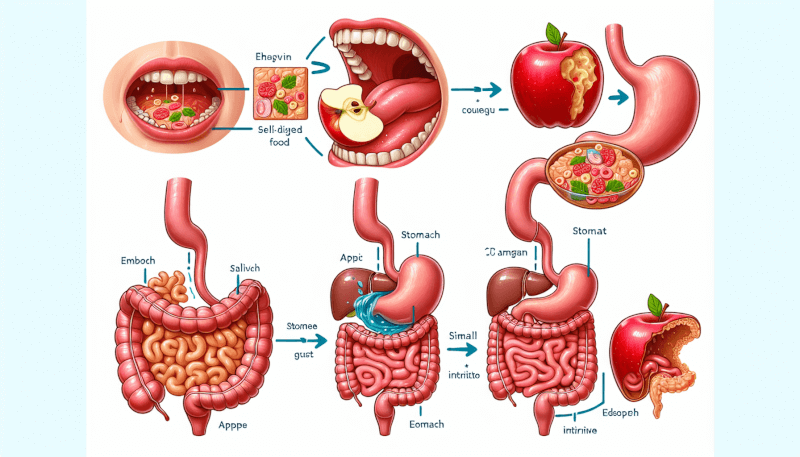Have you ever wondered about the intricate workings of your digestive system? Look no further than “Vol. 1: The Digestive System,” where you’ll embark on a journey through the fascinating world of digestion. From the moment food enters your mouth to its final journey through your intestines, this article will take you step by step, explaining the complex processes that occur within your body. So sit back, relax, and prepare to be amazed by the incredible efficiency of your digestive system.

An Overview of the Digestive System
The digestive system is an essential part of your body that plays a crucial role in breaking down the food you eat into nutrients that your body can absorb and use for energy, growth, and repair. It is responsible for the digestion, absorption, and elimination of food and waste materials. Without a properly functioning digestive system, your body would not be able to extract the necessary nutrients from the food you consume, leading to malnutrition and various health issues.
Components of the Digestive System
The digestive system consists of several interconnected organs and structures that work together to ensure proper digestion and absorption of food. These components include the mouth and salivary glands, esophagus, stomach, small intestine, large intestine, pancreas, liver, gallbladder, appendix, and anus/rectum.
The Mouth and Salivary Glands
Structure and Function of the Mouth
The mouth serves as the entry point for food into the digestive system. It is responsible for the mechanical and chemical breakdown of food through processes such as chewing and saliva production. The mouth is lined with mucous membranes, which contain taste buds that allow you to differentiate between different flavors.
The Role of Salivary Glands
Salivary glands, located within and around the mouth, produce saliva that helps moisten food and begin the process of digestion. Saliva contains enzymes, such as amylase, that break down carbohydrates into simpler sugars. Additionally, saliva helps in the formation of a food bolus, which makes it easier for swallowing to occur.
The Esophagus
Introduction to the Esophagus
The esophagus is a muscular tube that connects the mouth to the stomach. It serves as a passageway for food to travel from the mouth to the stomach through a process called peristalsis. The esophagus consists of layers of smooth muscle that contract and relax to push food downward.
Functions of the Esophagus
The primary function of the esophagus is to transport food from the mouth to the stomach. It achieves this through muscular contractions known as peristalsis. The esophagus also plays a role in preventing gastric reflux by the contraction of the lower esophageal sphincter, which acts as a barrier between the stomach and the esophagus.

The Stomach
Structure and Anatomy of the Stomach
The stomach is a muscular organ located in the upper abdomen. It has a J-shaped structure and consists of several layers of muscle and specialized cells. The inner lining of the stomach is covered with gastric pits that contain cells responsible for producing digestive enzymes and hydrochloric acid.
Functions of the Stomach
The stomach performs several important functions in the digestive process. It continues the mechanical breakdown of food initiated in the mouth through muscular contractions, mixing food with digestive juices. The stomach also secretes digestive enzymes, such as pepsin, which break down proteins, and gastric lipase, which breaks down fats. Additionally, the stomach plays a crucial role in the absorption of water, alcohol, and some medications.
The Small Intestine
Structure and Anatomy of the Small Intestine
The small intestine is a long, narrow tube located between the stomach and the large intestine. It consists of three main segments: the duodenum, jejunum, and ileum. The inner lining of the small intestine is covered in finger-like projections called villi, which increase the surface area for nutrient absorption.
Functions of the Small Intestine
The primary function of the small intestine is the absorption of nutrients from digested food. It achieves this through the actions of the villi, which contain specialized cells that facilitate the absorption of carbohydrates, proteins, fats, vitamins, and minerals. The small intestine also produces digestive enzymes, such as sucrase, lactase, and lipase, to further break down complex nutrients into simpler forms for absorption.

The Large Intestine
Structure and Anatomy of the Large Intestine
The large intestine, also known as the colon, is a wider tube that follows the small intestine. It consists of several segments, including the cecum, ascending colon, transverse colon, descending colon, sigmoid colon, and rectum. The large intestine is primarily responsible for the absorption of water and electrolytes, as well as the formation and elimination of solid waste.
Functions of the Large Intestine
The main function of the large intestine is to reabsorb water and electrolytes from the undigested food residue, converting it into semi-solid waste material called stool. The large intestine also houses trillions of beneficial bacteria, known as gut microbiota, which play a vital role in maintaining a healthy digestive system by fermenting undigested carbohydrates and producing vitamins.
The Pancreas
Structure and Anatomy of the Pancreas
The pancreas is a glandular organ located behind the stomach. It has both endocrine and exocrine functions. The exocrine portion of the pancreas produces pancreatic enzymes that aid in the digestion of carbohydrates, proteins, and fats. The endocrine portion of the pancreas secretes hormones, such as insulin and glucagon, which regulate blood sugar levels.
Functions of the Pancreas
The pancreas plays a critical role in the digestion of food by producing and secreting digestive enzymes into the small intestine. These enzymes, including amylase, lipase, and trypsin, break down carbohydrates, fats, and proteins, respectively. Additionally, the pancreas produces bicarbonate ions, which neutralize the acidic chyme coming from the stomach, creating an optimal pH for digestive enzyme activity in the small intestine.

The Liver and Gallbladder
Structure and Anatomy of the Liver
The liver is the largest internal organ in the body and is located in the upper right abdomen. It has a complex structure consisting of lobes and specialized liver cells called hepatocytes. The liver receives nutrient-rich blood from the digestive system and performs numerous vital functions, including the production of bile.
Functions of the Liver
The liver has numerous essential functions in the digestive system. It produces bile, a greenish-yellow fluid that aids in the digestion and absorption of dietary fats. The liver also metabolizes nutrients, detoxifies harmful substances, stores vitamins and minerals, regulates blood glucose levels, produces blood-clotting proteins, and removes bacteria and old red blood cells from the bloodstream.
Structure and Anatomy of the Gallbladder
The gallbladder is a small, pear-shaped organ located beneath the liver. It stores and concentrates bile produced by the liver until it is needed for digestion. The gallbladder has a muscular wall that contracts and releases bile into the small intestine through a duct called the common bile duct.
Functions of the Gallbladder
The gallbladder’s main function is to store and concentrate bile produced by the liver. When fatty foods are consumed, the gallbladder contracts, releasing concentrated bile into the small intestine. Bile helps in the emulsification and breakdown of fats, enabling their efficient digestion and absorption.
The Appendix
Introduction to the Appendix
The appendix is a small, finger-like pouch located at the junction between the small intestine and the large intestine. While its exact function is not entirely clear, the appendix is believed to play a role in immune function and the restoration of gut bacteria following illness or diarrhea.
Functions of the Appendix
Though the appendix is often considered a vestigial organ with no significant function, recent research suggests that it may serve as a reservoir for beneficial gut bacteria. In times of illness or diarrhea, the appendix can repopulate the intestine with these bacteria, aiding in the restoration of a healthy gut microbiome.

The Anus and Rectum
The Role of the Anus and Rectum in Digestion
The anus and rectum are the final parts of the digestive system responsible for the elimination of waste materials from the body through a process called defecation. The rectum acts as a storage area for feces, while the anus functions as the exit point for the elimination of stool.
Functions of the Anus and Rectum
The anus and rectum work together to control the elimination of waste materials. The rectum stores feces until they can be expelled through the anus. The anus itself contains muscular rings called sphincters that relax and contract to allow for the passage of stool. Additionally, the anus and rectum are lined with specialized cells that aid in the detection of stool, triggering the urge to defecate.


